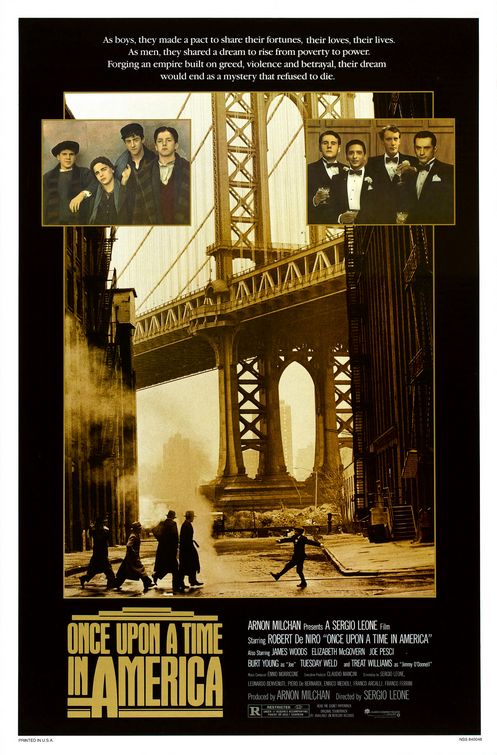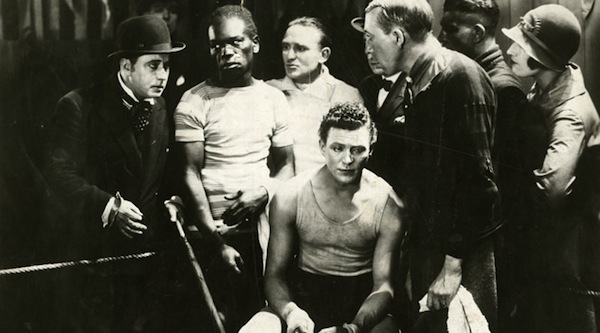Ahoy, squirts! Quint here. With this being my first Cannes you’d think the new films from people like David Cronenberg, Takashi Miike, Bernardo Bertolucci, Andrew Dominik and Jeff Nichols would be my most anticipated. And I am greatly looking forward to all of those, of course, but I’ve found the films I bent my schedule around the most, the ones I had to make work at all costs, were some of the classics programming.
Up for discussion today is the 4 hour and 13 minute extended cut of Sergio Leone’s Once Upon A Time In America and one of the saved Alfred Hitchcock silent films The Ring.
I mean, as much as I like Miike and Cronenberg… how do you compete with Leone and Hitchcock, really?

Martin Scorsese’s Film Foundation oversaw the new cut of OUATIA, featuring partially extended and wholly new scenes. Unfortunately the negatives for these moments are long gone, but the answer print positives they recovered aren’t hugely jarring. It actually made it easier for me to recognize what was new and what wasn’t as it has been quite a while since I’ve watched the film.
Now, I’m going to go into some spoilers here as I talk a bit about the new scenes cut into the film, so be warned if you’ve yet to see the film… I will be talking about some of the bigger twists and turns the story takes.
The movie jumps around in time, following Robert De Niro’s character, Noodles, throughout his life. The man’s a criminal, but he’s also a fiercely loyal friend and we get to know Noodles and his friends, Maxie (James Woods) and Cockeye (William Forsythe) from childhood through to young adulthood and, eventually, old age. Well, those who make it to old age, that is.
Ennio Morricone’s score for this film is fantastic and the maestro came in and helped orchestrate the music over the new scenes as the footage they recovered only had the on-the-set audio and no music on the soundtrack. Score-wise it was a pretty flawless transition.
Of the added scenes the one that stood out to me the most was a new scene from when Old DeNiro visits the fancy crypt of his fallen friends and finds a plaque saying he paid for it… which comes a bit of a surprise since he disappeared and started a new life when the shit hit the fan. In the regular cut DeNiro discovers a lock box key hanging off the plaque and then it cuts to him using it.
In this cut he’s interrupted by Louise Fletcher, who is in charge at the cemetery and hopes this old dude snooping around this particular crypt is her mysterious client. In name he is, but he most assuredly isn’t her client.
I understand why this scene was cut because it’s pretty much just DeNiro asking all the questions we have. Who commissioned this crypt? Who designed it? Why are there speakers with Cockeye’s pan flute main theme playing on a loop? Fletcher doesn’t have any answers for him and he doesn’t have any answers for her, so you can see why they cut the scene. Apart from deepening the mystery a bit and introducing the mysterious black car (that later blows up) tailing DeNiro it doesn’t really serve the plot. It’s interesting to see, though, especially to see Fletcher interact with DeNiro.
Another notable addition was the post car-sex/rape/creepytime stuff, when DeNiro is at his lowest he goes out and gets plastered and meets Eve, the blonde lady who becomes his girl and gets shot at the very beginning of the movie. In the theatrical he just happens to have a blonde steady girlfriend when everything goes down and he has to disappear… this is how they met.
Not very romantic… he’s drunk, she’s willing to fuck for money, and he takes her to a hotel and calls her Deborah (his one true love… who he just happened to rape in the car earlier that evening). Of everything that was cut, this was probably the most crucial bit that explained a character randomly appearing later on in the movie… it also helps because Darlanee Fluegel looks a lot like Tuesday Weld and I remember being confused that she’s shot at the beginning of the movie, but then somehow shows up as an older woman as DeNiro shows up to the old neighborhood looking for answers. I mean, I figured it out eventually, but it was confusing.
One more I’ll go into detail on is a little scene between old Treat Williams and old James Woods, where it’s firmly established that the impassioned worker’s rights fighter from the old days is now the most corrupt, twisted stooge and has Woods’ Maxie wrapped around his little finger.
We get a pretty clear idea that Woods is in a tough spot when DeNiro finally discovers that he’s not dead, but this scene tells you just how tough as Williams essentially has Woods backed into such a corner that he signs away everything he has just before DeNiro shows up.
There a ton of little moments added throughout, extended scenes, etc, but those were the big ones that stood out for me.
For the most part what was cut isn’t missed in the regular version of the film, but it’s fascinating to see as a film fan if for no other reason than to see Leone’s process.
Once Upon A Time In America is not Leone’s best film… the twist is kind of limp and the ending annoyingly ambiguous, but that first act is incredible and everything from Noodles’ childhood is magic. The finale doesn’t really support the lead-in, but it’s still an impressive film and Leone’s directing skills were as sharp as ever.
It was also interesting watching the film with an audience filled with people who had clearly never seen it and the very real gasps of shock as Fat Moe is getting brutally beaten at the very beginning of the film made me smile.
And that brings us to Alfred Hitchcock’s The Ring, saved and restored by the BFI, The Hollywood Foreign Press Association and, once again, Scorsese’s Film Foundation.

The most interesting thing about this silent film is it represents Hitchcock’s one and only original screenplay credit. As a Hitchcock fan it’s also a fascinating early indication of his talent at visual storytelling.
In one corner you have One Round Jack (Carl Brisson), a carny boxer in love with the ticket taker girl, and in the other you have an Australian heavyweight champion who cleans Joe’s clock and works damned hard to steal his woman all in one scene.
Joe fights all comers for one pound… if the challenger wins, he gets big money payout, but up until he gets tricked into the ring with a real world heavyweight champ, Joe has never lost.
Now this sneaky Aussie, Bob Corby (Ian Hunter), didn’t intend to humiliate this poor sap, but he ends up showing off for Jack fiancée. From this point on, Jack is invited to be Bob’s sparring partner, but more so Bob can continue to woo his girl.
It becomes a fight for more than honor and reputation as Jack has to work his way up the ranks in order to challenge Bob for his title and for the love of his girl.
The first third of the movie moves super fast. Bob seduces Lillian Hall-Davis’s character while One-Round Jack is blissfully ignorant, thinking his career is finally taking off. In his mind, he has his girl and his whole life ahead of him.
And it’s funny. There’s a wedding scene with a lot of the carnival people in attendance… seeing the Siamese Twins fighting over which side of the aisle to sit on was hilarious and totally a Hitchcock moment. There’s also a trainer character, played by Gordon Harker, who made full use of every inch of the screen he could work his way into. Standing in the background, he’d be picking his nose, diggin in his ear, reacting comically to whatever was going on. The closer he got to the camera the more he’d ratchet up his goofiness, which made him one of the most welcome actors of my Cannes 2012 so far… some 85 years after this film was released.

After the wedding, things get a bit drawn out and muddled until the big closing fight, but I still found the whole thing entertaining.
Alright, gotta get to some more Cannes reviews. Can’t wait to write up Ben Wheatley’s Kill List follow-up SIGHTSEERS, one of the best things I’ve seen at the fest so far… let’s call it a psychotic romantic comedy. Check for that write-up soon.
-Eric Vespe
”Quint”
quint@aintitcool.com
Follow Me On Twitter

